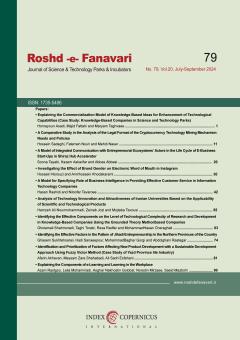Identification and prioritization of factors affecting new product development with a sustainable development approach using fuzzy Victor method (Case study of Yazd province tile industry)
Subject Areas : مديريت تحقيق و توسعه
Afarin Akhavan
1
*
![]() ,
Meysam Zare Shahabadi
2
,
Ali Sadri Esfahani
3
,
Meysam Zare Shahabadi
2
,
Ali Sadri Esfahani
3
1 - Science and Arts University
2 - Science and Arts University
3 - Industrial Engineering Group, Science and Arts University, Yazd, Iran
Keywords: Product Development, Sustainable Development, fuzzy VIKOR, Tile Company, Energy, Pollutants, Effluents and Wastewater,
Abstract :
Sustainable development is a development that can meet the current needs of the organization without compromising the ability of the next generation to meet their needs. New product development is a key strategy for companies to survive and survive in a competitive market. The purpose of this study is to identify and prioritize the factors affecting new product development with a sustainable development approach in the tile industry of Yazd province. In the first part of the study, by examining the background of new product development with a sustainable development approach, the factors affecting it have been identified. In the second part, prioritization of these factors has been done using fuzzy VIKOR technique. The statistical population of the study is all experts, managers of tile factories and specialists familiar with the subject of research who were selected as a sample by purposive sampling of 10 experts. The result of implementing this method led to the identification of 16 factors. Accordingly, the factors of the organization's commitment to comply with environmental laws in design, attention to optimizing the amount of energy required in the phases of determining materials, design and development of new products and attention to the effects of pollutants, effluents and wastewater production The new product is in the first to third ranks, respectively, of the factors affecting the development of the new product with a sustainable development approach in the tile industry.
5- شيباني اصل، نسيم، دليلي، امير، موسوي، زهرا سادات، توسعه پايدار در کسب و کار، دهمين همايش ملی پژوهش هاي مديريت و علوم انساني در ايران، تهران، 1400.
6- صالحيان، سعيد، مسلمي، زهرا، شيبم، حميدرضا، نجفي، اسماعيل، ارزيابي نقش نواحي صنعتي در توسعهي پايدار روستايي (مطالعه موردي: دهستان مشک آباد شهرستان اراک)، نگرشهاي نو در جغرافياي انسانی، 12(2)، 131-117، 1399.
7- درويشي، محمدرسول، قائدي، محمدرضا، کشيشيان سيرکي، گارينه، توحيدفام، محمد، تحليلي بر توسعه پايدار شهري با تکيه بر شاخصههاي سرمايه اجتماعي و اعتماد عمومي (نمونه موردي: منطقه ۲ شهر تهران)، فصلنامه علمی-پژوهشی پژوهش و برنامهريزی شهری, 11(40), 201-216، 1399.
8- شوال پور, سعيد, طيبيجاويد, الهام، گونه شناسي عوامل تاثيرگذار بر موفقيت يکپارچهسازي دانش در پروژههاي توليد و توسعه محصولات و سيستمهاي پيچيده (مورد مطالعه: صنايع هوايي ايران)، فصلنامه مديريت توسعه فناوري, 8(1), 93-126، 1399. doi: 10.22104/jtdm.2020.3900.2368
9- سليمي زاويه، سيدقاسم، فکري، رکسانا، ارايه روشي جهت شناسايي و رتبهبندي ريسکهاي فرايند توسعه محصول جديد در صنايع خودروسازي ايران با استفاده از روش ترکيبي ANP-DEMATEL، فصلنامه تخصصي رشد فناوري، 15(59)، 18-9، 1398.
10- دهقانيپوده، حسين، چشمبراه، محسن، ترابي، حسن، کريمي گوارشکي، محمدحسين، حسنوي، رضا، تعيين و اولويتبندي شاخصهاي مؤثر بر برونسپاري پروژههاي تحقيق و توسعه محصولات با سامانههاي پيچيده (مورد مطالعه: سازمان صنايع هوايي)، فصلنامه مديريت توسعه فناوري، 5(3), 139-168، 1396. . doi: 10.22104/jtdm.2018.2699.1910
11- نقي زاده، محمد، منطقي، منوچهر، نوري فاطمه، تبيين عوامل مؤثر بر موفقيت همکاريهاي مشترک در پروژههاي طراحي و تجاري سازي محصول جديد در صنعت هوايي. فصلنامه مديريت توسعه فناوري، 6(4), 31-54، 1397. . doi: 10.22104/jtdm.2019.2743.1927
12- ابراهيمپور ازبري، مصطفي، مرادي، محمود، ميرفلاح دموچالي، رضوانه، تأثير قابليت فناوري اطلاعات و قابليت يکپارچگي زنجيره تأمين بر عملکرد توسعه محصول جديد: نقش تعديلگري ظرفيت جذب دانش. فصلنامه مديريت توسعه فناوري، 6(2), 109-136، 1397. doi: 10.22104/jtdm.2018.2870.1970
1- Duran, DC, Gogan, LM, Artene, A, Duran, V., The components of sustainable development-a possible approach, Procedia Economics and Finance, 2015, 1;26:806-11.
2- Bossel, H. Indicators for sustainable development: theory, method, applications, Winnipeg: International Institute for Sustainable Development; 2000.
3- Lam, PK, Chin, KS, Pun, KF, Managing conflict in collaborative new product development: a supplier perspective, International Journal of Quality & Reliability Management, 2007, 16;24(9):891-907.
4- Chu, D, Gilman, S. Methanol electro‐oxidation on unsupported Pt‐Ru alloys at different temperatures, Journal of the Electrochemical Society, 1996, 1;143(5):1685.
13- D'Adamo, I, Gastaldi, M, Morone, P. Economic sustainable development goals: Assessments and perspectives in Europe, Journal of Cleaner Production, 2022, 20;354:131730.
14- Wang, L, Xu, Y, Lee, H, Li A, Preferred product attributes for sustainable outdoor apparel: A conjoint analysis approach, Sustainable Production and Consumption, 2022, 1;29:657-71.
15- Wang, Y, Modi, SB, Schoenherr, T, Leveraging sustainable design practices through supplier involvement in new product development: The role of the suppliers' environmental management capability, International Journal of Production Economics, 2021, 1;232:107919.
16- Garcia-Garcia, G, Azanedo, L, Rahimifard, S, Embedding sustainability analysis in new food product development, Trends in Food Science & Technology, 2021, 1;108:236-44.
17- Yu, Z, Ridwan, IL, Tanveer, M, Khan, SA, Investigating the nexuses between transportation Infrastructure, renewable energy Sources, and economic Growth: Striving towards sustainable development, Ain Shams Engineering Journal, 2023, 1;14(2):101843.
18- Devi, K, Extension of VIKOR method in intuitionistic fuzzy environment for robot selection, Expert Systems with Applications, 2011, 1;38(11):14163-8.
19- Liou, TS, Chen, CW, Subjective appraisal of service quality using fuzzy linguistic assessment, International Journal of Quality & Reliability Management, 2006, 23(8): 928-943.
20- Bazzazi, AA, Osanloo, M, Karimi, B, Deriving preference order of open pit mines equipment through MADM methods: Application of modified VIKOR method, Expert Systems with Applications, 2011 1;38(3):2550-6.

